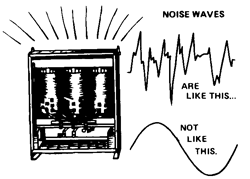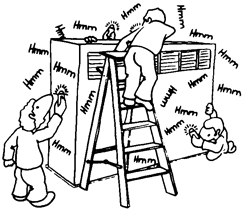Transformer Noise Factor

Understanding Transformer Noise:
Noise is defined as unwanted sound. Transformer "humming" has been known to soothe people but generally it is thought to be a nuisance. The causes and reduction of transformer noise has come to prominence again. The reason for this transformers are being placed closer to the populace like high rise office buildings, apartments, shopping malls and in their gardens. When placing a transformer it is becoming necessary to locate these units carefully and some planning. The best rule is plan ahead. Finding out you have a noise problem after the placement of this unit is costly, time consuming and frustrating. It is absolutely necessary to consider each case and apply the general rules of acoustic technology and be familiar with what causes transformer noise.
Transformer's Hum:
Transformer noise is caused by a phenomenon called magnetostriction. In very simple terms this means that if a piece of magnetic sheet steel is magnetized it will extend itself. A transformer is magnetically excited by an alternating voltage and current so that it becomes extended and contracted twice during a full cycle of magnetization. A transformer core is made from sheets of special steel. The reason it is construction in this matter is to reduce losses and to reduce the heating effect. They are sufficient to cause a vibration, and as a result noise. The act of magnetization by applying a voltage to a transformer produces a flux, or magnetic lines of force in the core. The degree of flux will determine the amount of magnetostriction and hence, the noise level. The obvious answer is reduce the amount of flux to reduce the nose. But it is not that simple, transformer voltages are fixed by there system requirements, and the amount of magnetization, by the ratio of these voltages to the number of turns in the winding. The decision on what ratio of voltage to turns will be mainly economic. It means that the amount of flux at the normal voltage is invariably fixed, thus setting the noise and vibration level. Also increasing or decreasing magnetization does not increase or decrease the magnetostriction by the same amount. In technical terms the relationship is not linear. Therefore, we can not reduce the noise level at the source. We now know that the transformer hum is caused by the extension and contraction of the core laminations when magnetized. We can expect this extension and contraction to take place twice during a normal voltage or current cycle. What this means is the transformer is vibrating at twice the frequency of the supply. This is called the fundamental noise frequency. Since the core is not symmetrical and the magnetic effects do not behave in a simple way, the resultant noise is not pure in tone. They are not equally important and we find that the first and third harmonics predominate and produce most of the transformer sound. What proportion of the transformer noise is contributed by the windings and does the noise increase as the load increases?. There are mechanical forces existing between individual conductors in a winding when the transformer is excited. These forces will produce a vibration and a noise, but only one which is pure in tone, i.e. at twice the exciting frequency. This, however, is swamped by the fundamental and harmonics produced by the core. We know now that the noise from a transformer is caused by mechanical movement of the individual lamination of the core under magnetization. The pulsation will cause not only air disturbances, thus producing noise, but also physical vibration of the core structure and everything attached to it. The vibration will have similar frequencies to those measured in the noise analysis. Reducing these mechanical pressure pulsations is vital to noise and vibration control and consequently, isolating the core and coils of a transformer, either in the tank or through a tank, or just as the core and coils, is important. Baffling transformer noise and forgetting to isolate the vibrations will only lead to a disappointing result and is something which should not be done. Noise is usually air borne. Vibration is ground borne. They are very much connected.
Cutting Air Born Noise:
Putting the transformer in a room in which the walls and floors are massive enough to reduce the noise on the other side. Walls can be of brick, steel, and concrete. Noise is usually reduced as it tries to pass through a massive wall. Putting the transformer inside an enclosure which uses a limp wall technique. This is done by using two thin plates separated by a rubbery material. The noise hits the inner sheet and some energy is used up inside the viscous material. the outer sheet should not vibrate Build a screen wall around the unit. It will reduce the noise to those near the wall, but the noise will get over the screen and fall elsewhere. Screens have been made from wood, concrete, brick and dense bushes.
Some useful pointer in helping reduce transformer noise levels:

- First assess what level is tolerable. Isolation of the transformer from the ground is vital. Installation must ensure that nobody tightens down shipping bolts but removes them. Connecting cables must be as flexible as possible. Ventilation ducts must be placed in positions where these are effective thermally with affecting the acoustic performance. Transformer noise is difficult to change at the source. Flux density reduction is the main thrust, but this means increased cost. Transformer core constructions help. Reputable manufacturers will use good joints, flat steel, consistent thickness, good core supports, few bolts.
- Noise reduction by distance is the simplest form. If you can do this with out to much cost excellent.
- Noise reduction by screens, bushes and etc. is the next simplest . Remember the shadow effect means the noise could be heard outside the shadow of that screen.
- Full enclosure is usually the only option for a troublesome transformer. Full enclosure can be made of any material with a high mass/weight ratio.
- Pay close attention to access doors and removable covers on enclosures. Tight fits are essential Watch the dimensions of rooms in which units are mounted. Damp them if necessary, suitable for transformer frequencies. choose damping materials compatible with transformer frequencies.
- Carry out sound surveys before and after installations. Remember to do a frequency analysis so that transformer noise can be differentiated.
- Remember transformers need cooling air in rooms. Be careful when you position air ducts, ventilators and grilles.
- Make sure the vibration isolators are correctly mounted and will accommodate transformer frequencies.
- Consider very carefully where transformers will be mounted. Resilient structures such as wooden mezzanines might be harmful.
- Go back to the previous page.
- Use the search bar at the top of the page to search for your products.
- Follow these links to get you back on track!
Store Home | My Account

 United States
United States